Separate motorized special purpose battalions of the Red Army
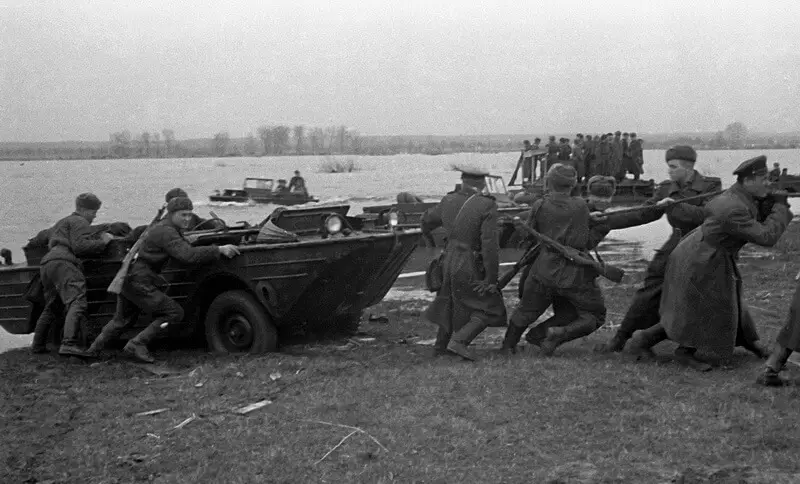
Soldiers of one of the troops during the crossing of the river. Oder
Moving to the West and liberating the territories occupied by the Nazis, the Workers 'and Peasants' Red Army regularly crossed rivers and other water barriers. Since the summer of 1944, specialized military units - separate motorized battalions for special purposes - have participated in such operations. They received special equipment, with the help of which they had to cross bodies of water on the move, capture bridgeheads and ensure the crossing of the main forces.
Special Purpose Parts
In 1943, the Red Army seized the strategic initiative and began moving westward. During the offensive on all fronts, she regularly had to cross rivers and other bodies of water. The available fleet of means of overcoming water obstacles generally corresponded to the tasks being solved, but it was not without limitations and difficulties that led to increased risks.
Based on the accumulated experience of offensive operations and river crossings, at the beginning of 1944, the concept of a new specialized formation was developed - a separate motorized battalion for special purposes (omb OSNAZ or ombon). Such a unit had to have a special composition and fleet of equipment, allowing it to cross water obstacles without additional preparation, gain a foothold on the opposite bank and ensure the approach of the main forces.
In the spring and summer of 1944, a total of 11 separate motorized OSNAZ battalions were formed with numbers 72 (Guards), 252, 271-275 and 283-286. At the end of May, the first of them, the 271st, joined the active army. During June, five more battalions appeared at the front, and in August the next two. At the end of December, the newly formed 72nd Guards Ombon entered the active army. The last to reach the front in April 1945 was the 286th battalion.
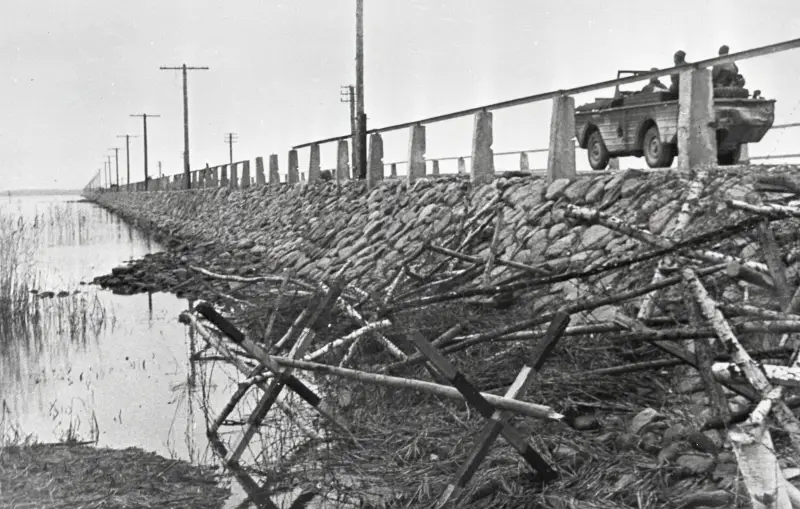
Amphibious Ford GPA, presumably from the 283rd detachment on the Moonsund archipelago
Almost all separate motorized battalions continued to serve without changes and were present at the front until the very end of the war. The only exceptions were the 275th and 284th special forces - in November 1944 they were taken to the rear and returned to the active army at the end of April 1945. In August-September, the 275th battalion had to go to the Far East to participate in battles against Japan.
After the end of World War II, separate motorized OSNAZ battalions remained in the Red and Soviet armies, but were soon abandoned. No later than 1946-47. they were all disbanded.
According to staffing schedule
The organizational and staffing structure of individual motorized special-purpose battalions was formed taking into account their tasks and the specifics of the intended combat operations. The overall safety level of all battalions was the same, with rare exceptions. As the service continued and participation in battles, it was not radically changed.
The typical composition of the ombon included a control company, two motorized companies, a mortar company, an anti-aircraft machine gun company, an engineer company and a service company. The total number of battalion personnel is approx. 616 people
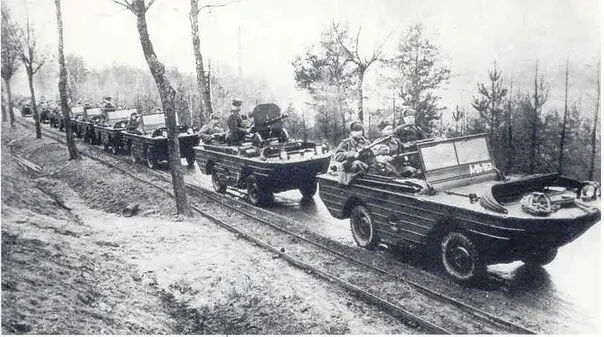
Amphibians of one of the OSNAZ ombs. The second vehicle in the convoy carries a heavy machine gun
To ensure high mobility and the ability to cross water obstacles on the move, the battalion had about a hundred Ford GPA amphibious vehicles. There were also domestic or imported vehicles for auxiliary purposes, capable of traveling only on land.
The main strength of the battalion were two motorized companies. This unit included two platoons of machine gunners and one platoon of rocket launchers. In both cases, the platoon consisted of three sections with appropriate weapons. The platoon had four GPA vehicles - one for the squad and one for the commander.
The main weapons of a platoon of submachine gunners were PPSh or PPS submachine guns. The platoon was also equipped with one DP-27 machine gun. The platoon of rocket launchers was equipped with foreign anti-tank weapons - 3 units each. for each department. The bulk of the motorized battalions received American M1 Bazooka grenade launchers, and the 252nd unit received British PIAT products.
The battalion's mortar company had three platoons of three mortars each. 82 mm battalion mortars were used, suitable for carrying or transport. Each mortar crew used its own amphibious vehicle; Another vehicle was assigned to the platoon commander.
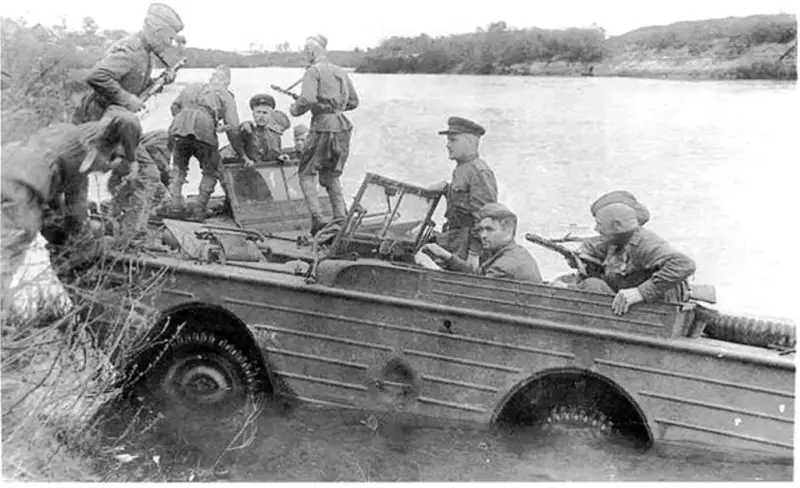
Soldiers of the 275th detachment during the fighting in Karelia
The battalions had their own sapper companies with sapper, engineer-mine and demolition platoons. The company had five amphibians and the same number of trucks. She was responsible for conducting engineering reconnaissance, neutralizing occupied positions, etc.
The tasks of air defense and fire support on land/on water were assigned to a three-platoon anti-aircraft machine gun company. The anti-aircraft platoon had three semi-trucks with a DShK machine gun in the back. The presence of nine heavy machine guns seriously increased the firepower of the battalion.
It should be noted that the OSHS and the OMB OSNAZ weapons system could be changed and improved taking into account the accumulated experience. Thus, proposals to change the composition of small arms in the direction of increasing the number of machine guns were repeatedly expressed and implemented. In addition, grenade launchers complained about the unsuccessful PIAT product and demanded more effective anti-tank weapons.
Battalions at the front
The concept assumed that separate motorized OSNAZ battalions would accompany formations from the division and above, helping them cross water barriers. Moreover, the use of such units was planned only in those sectors of the front where large operations to cross rivers were planned. As a result, each front required no more than one or two battalions at a time.
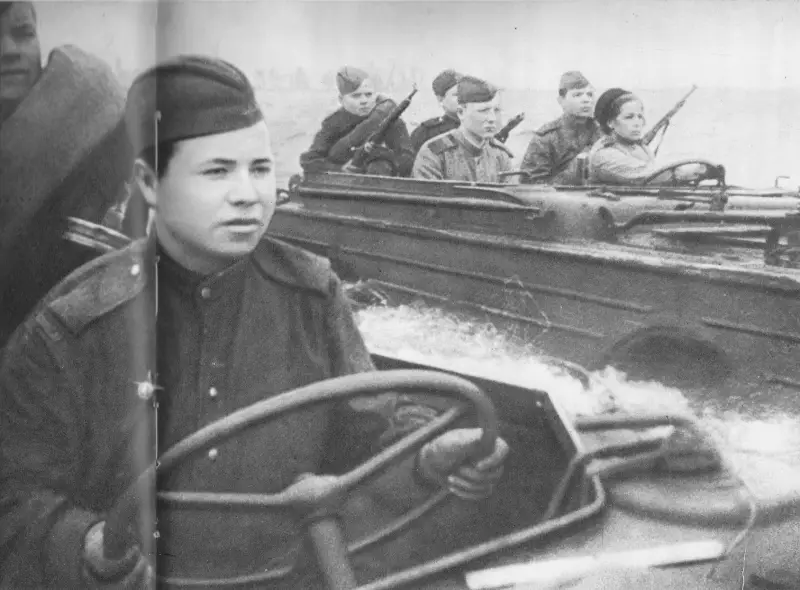
Submachine gunners cross the river. Oder
A fairly simple but effective tactic for using the battalion was proposed. His motorized and sapper company in amphibious vehicles, supported by an anti-aircraft machine-gun company or artillery from adjacent formations, had to cross a river or reservoir and occupy a bridgehead on the opposite bank. Their task was to push the enemy away from the coastline to ensure the safety of the main crossing for the main forces. At the same time, the battalion's amphibians were supposed to act as a transport means for the main forces.
After the crossing, riflemen, tank and other units had to take the battle and develop the offensive. At the same time, OSNAZ bombs could help them or work as maneuver forces to break deep into the enemy’s defense.
This tactic was first tested on June 21, 1944 during the Svir-Petrozavodsk operation. The 275th and 284th special forces operated as part of the Karelian Front and successfully ensured the transportation of rifle and tank units across local rivers. So, the 275th battalion worked on the river. Svir. His motorized and sapper company reached the opposite bank at a given time and took the fight. Over the next 35-40 minutes, sappers made several passages for equipment in enemy minefields. At the same time, the machine gunners occupied an area 400 m wide along the front and 1,5 km deep. At the same time, Ford GPA crews transported infantry across the river.
After crossing the Svir, two battalions joined the main forces and took part in the ground offensive. If necessary, they carried out their main task and captured bridgeheads.
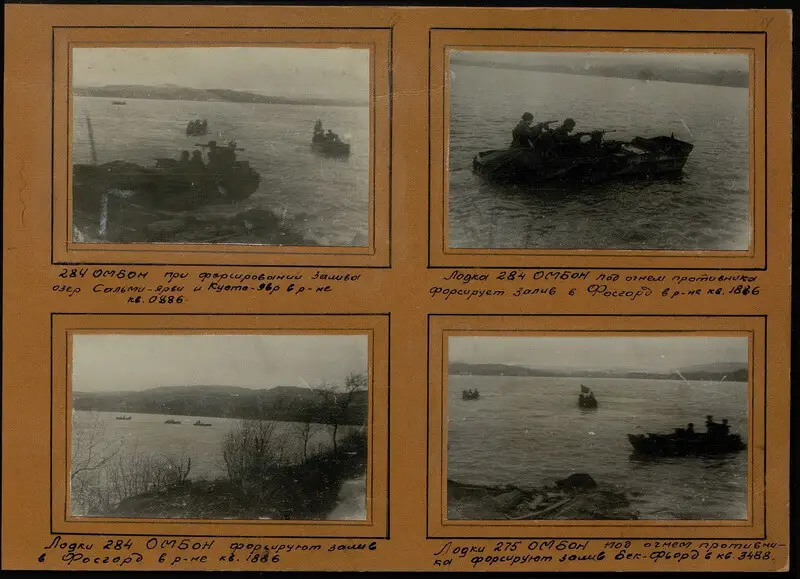
Front-line photo album with photographs of motorized units of different ombos
After June 1944, separate motorized battalions were actively used along the entire front almost until the very end of the Great Patriotic War. They participated in all the main operations of the Red Army and ensured the crossing of all large and medium-sized rivers on the army’s battle route. At the same time, as in the case of the events of June 1944, the combat work of the ombon was not limited to just seizing bridgeheads - they were often used as maneuverable motorized rifle units.
In April 1945, the 273rd, 283rd and 286th battalions were involved in the Berlin operation. They were supposed to ensure the movement and maneuver of our forces near and in the German capital. As part of the operation, the three battalions again had to take control of the bridgeheads, as well as transport the main forces along rivers and canals. The battalions did not play a leading role in the operation, but their importance should not be underestimated.
Practice and experience
During the battles of the Great Patriotic War, the Red Army accumulated, systematized and profitably applied experience in various fields and contexts. Thus, the operations of 1943-44. on river crossings showed the need to develop army crossing facilities and create specialized amphibious formations. Already in mid-1944, new battalions, capable of crossing water obstacles on the move, went into battle and proved themselves well. They carried out their tasks until the end of the war and made a significant contribution to the future victory.
After the war, amphibious ombons were abandoned. However, the experience of their combat use formed the basis of post-war concepts for the development of ground forces. The main result of this was the fundamental decision to develop amphibious armored vehicles for infantry. Thanks to this, rifle units were able to independently cross water obstacles, without waiting for help from other units and without being exposed to unjustified risks. Thus, 11 separate battalions from the Great Patriotic War determined the path of development of domestic equipment for the next few decades.
Information